
 1663
1663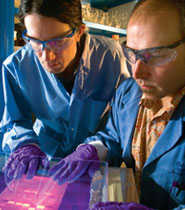
|
|

Silent SentriesIntelligent Detectors in a Shifting Nuclear Landscape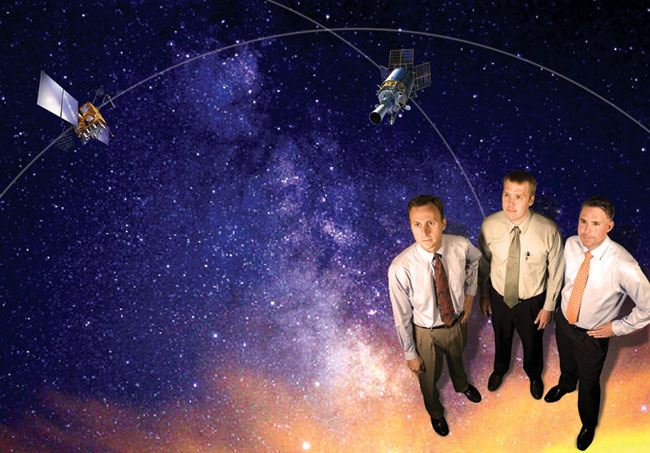
Marc Kippen, Eric Dors, and Dave Smith head teams responsible for building instruments that detect nuclear explosions anywhere on or above Earth's surface.
The Limited Test Ban Treaty came into being during the summer of 1963, just 18 years after a mushroom cloud swept the first atomic bomb's radioactive remains miles into the sky. With a stated desire to put an end to both "the contamination of man's environment by radioactive substances" and "the armaments race," the treaty prohibited nuclear explosions on Earth's surface, in its atmosphere or oceans, or in space. Six days after the treaty went into effect, the United States launched a pair of satellites, the Velas, to verify compliance. The Velas were followed over the years by other satellites, dozens of them, each carrying various packages of gamma-ray and neutron detectors, x-ray telescopes, or radio and optical sensors—instruments that could detect the telltale radiations of a nuclear blast. Those Cold War–era instruments, all built by Los Alamos (save the optical sensors, which were built by Sandia National Laboratories) were robust, highly reliable, and well suited for monitoring a world with six declared nuclear-weapons states: the United States, the Soviet Union, the United Kingdom, France, China, and India. But then the world changed. "The Berlin Wall came down in '89, the Cold War ended, and the nuclear threat just seemed to metastasize," recalls Mark Hodgson, a senior program manager and unofficial historian for the Satellite Nuclear Detonation Detection (SNDD) program at Los Alamos. "The world was suddenly full of nuclear-weapons information and strategic materials and, to a lesser extent, the engineering and economic capability to make a weapon." The nuclear landscape began to change rapidly. The Soviet superpower broke into four nuclear weapons states—Russia, Kazakhstan, Belarus, and Ukraine—then four became one when the latter three returned their weapons to Russia. Iraq was rumored to be developing weapons, and Pakistan detonated a device. In addition, there was the specter of terrorist bombs. To keep pace, monitoring in the 21st century would have to run a different race. Instruments would have to be savvier, sensors more able to detect a much-broader spectrum of signals, in greater detail and with higher sensitivity. But the enhanced sensors would also see countless "background" events, such as lightning flashes or cosmic-ray collisions. But the enhanced sensors would also see countless natural background events, such as lightning flashes or cosmic-ray collisions. Distinguishing a true nuclear signal from false background signals is the critical task of monitoring, a task performed primarily by ground-based supercomputers and human analysts. But the current SNDD group of some 200 scientists, engineers, and technicians is changing how the job gets done. It is building intelligent instruments that can rapidly assess the data while in space and look for probable events. Team members are also using advanced technologies to make the instruments smaller and lighter and to make them adaptable to different host satellites. And yes, they have made these marvelous instruments cost effective, too. Hostile Space"Simply put," says Eric Dors, the confident project leader in charge of fielding neutron and gamma-ray detectors, "our job is to detect a nuclear explosion, find out where it occurred, and estimate its yield." Dors' job description downplays what in reality is an exceedingly difficult task. The surface area of the Earth is more than half a billion square kilometers. (One kilometer is just over a half mile.) With a 100-kilometer-thick band of atmosphere tacked on, there are about 50 billion cubic kilometers to monitor. Actually . . . more. There's near-Earth space to monitor as well, a seemingly endless black "void" that happens to be as harsh as the Sahara for sensitive electronics. In reality, the void is filled with energetic charged particles that have become trapped by Earth's magnetic field. These particles collide with and blast away at a satellite's materials and also deposit charges (both positive and negative) on exposed surfaces. Charge imbalances can grow large enough to create electrical discharges, inducing currents inside the satellite that can interfere with and sometimes damage electronics. The particles also hit the sensors and are a major source of background signals. How major depends on the particle density, which depends in a complex way on the intensity of the solar wind—electrons and ions that race away from the sun at about 400 kilometers per second. On windy days some sensors will fire every few minutes. Occasionally, the sun will eject a large mass of material from its corona and precipitate a "storm" in near-Earth space, during which both the background signals and the potential for satellite damage get blown sky high. When the first treaty-verification satellites, the Vela Hotels, were launched back in 1963, little was known about "space weather." Each of the two inaugural satellites (the Velas were launched in pairs, six pairs in all) carried 30 x-ray, gamma-ray, and neutron sensors that had never before operated in space. Skeptics gave them two weeks to live. The sensors survived much longer, however, in part because the Velas orbited in a part of space where the charged-particle radiation wasn't severe. Those first-generation sensors worked like gangbusters and detected many nuclear events. (France and China delayed signing the Nuclear Test Ban Treaty and continued atmospheric testing until 1974 and 1980, respectively.) The Velas also detected plenty of background signals, unique data that researchers mined to investigate numerous natural phenomena. Their sensors were even the first to detect bursts of gamma rays originating from across the universe. A Model ProgramThe SNDD program's need to distinguish nuclear signals from backgrounds strengthened what had been a shotgun wedding between science and monitoring, making it an enduring marriage. Early on, the program realized that better knowledge of space weather, Earth's atmosphere, x-ray sources, gamma-ray bursts, and planetary science would help scientists discriminate detonation events from backgrounds. Conversely, scientists realized the program offered new opportunities for research. Strong ties developed with NASA, the University of New Mexico, and dozens of other institutions. For example, neutron-detection guru and Laboratory Fellow Bill Feldman began his career designing neutron detectors for the monitoring program, then went on to develop the NASA neutron detectors that helped discover water on the moon and Mars. Similarly, Los Alamos Fellow Ed Fenimore designed the gamma-ray trigger for nuclear-event detection, then used his expertise to design the sensor that alerts NASA's SWIFT satellite of a gamma-ray burst. Although scientific collaborations kept the mental juices flowing, the program endured because it attracted bright, exceptionally talented scientists and engineers, then passed the torch to them. 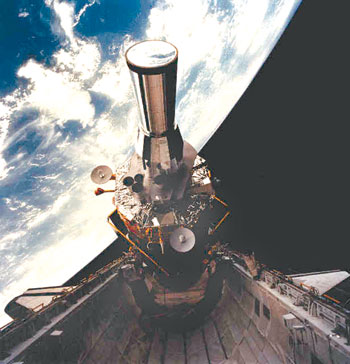 A Defense Support Program (DSP) satellite deploys from the Space Shuttle Atlantis, carrying instruments that detect nuclear events in space and monitor space weather. The photo is unique; all other DSPs were deployed from rockets. Credit: NASA Johnson Space Center (NASA-JSC) Dors is a prime example. Before joining Los Alamos, he was a NASA graduate research fellow and built plasma sensors for ionospheric sounding-rocket experiments. Marc Kippen, the project leader in charge of fielding x-ray instrumentation, is another example, as is Dave Smith, a project leader responsible for electromagnetic pulse (EMP) detection. (See "Nuclear Detection 101.") Kippen began working on the detection of gamma-ray bursts as a graduate student and continued that work as a postdoctoral student and research scientist with several universities and NASA. Smith, a confessed radio-hardware junkie, has worked in the satellite EMP group since completing his first year of college in 1989. Proud of "their" instruments, the three project leaders are equally proud of the teams that make those instruments work. "Some of our technicians have been with the program for decades," explains Kippen. "They're the ones that carry the mission memory. They know, for example, that if you anchor the circuit board 'this way,' instead of 'that way,' it will survive the launch and the severe temperature changes that occur every time the instrument rotates in and out of the sunlight." Success is also due to the program's sponsors, an interagency group that is part Department of Energy and part Department of Defense. Anything but timid, the sponsors have aggressively funded technology that provides capabilities way ahead of the present-day requirements. Changing of the GuardThe last of the man-sized Velas was sent skyward in 1969. It was followed into space by the enormous, schoolbus-sized Defense Support Program (DSP) satellites, orbiting observatories that were optimized for detecting explosions in space and the upper atmosphere. First launched in 1970, the satellites carry 10 separate instruments that were developed, built, and tested by Los Alamos. Monitoring the Earth's surface and lower atmosphere, originally done by the Vela satellites, eventually became the job of Global Positioning System (GPS) satellites—the same ones that made global navigation an easily accessible commodity. "Few remember this, but nuclear-event detection was used as one of the original justifications for the entire GPS program," says Smith, whose EMP sensors (along with optical sensors built by Sandia) fly on the dual military- and commercial-use satellites. The current system of 24 GPS satellites was declared fully operational in 1995—17 years after the first experimental one settled into its orbit. At least four satellites view any point on the surface of the Earth all the time. The downside to such complete coverage is that, for the EMP sensor, it increases a troublesome background: lightning, whose flash of light is accompanied by a burst of radio waves that can look very much like a nuclear EMP. "A true nuclear explosion would obviously warrant the attention of the highest levels of our government," says Smith. "Lightning strikes the Earth approximately 100 times a second, and needless to say, we can't go tapping the President on the shoulder every time there's a lightning flash." Sensing the New Nuclear WorldA sensor triggered by some event outputs a signal that is then evaluated to determine what kind of event it was (nuclear or other). Ground-based computers do most of the evaluating—very little is done by the instrument's relatively simple computer. (It takes so long to design and validate radiation-tolerant computer chips that a space computer, at liftoff, is significantly less powerful than what's available commercially.) 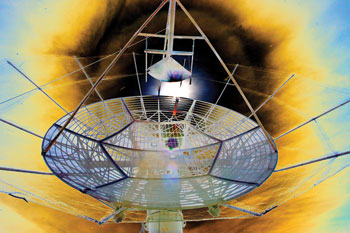
The Los Alamos Portable Pulser produces an RF signal that mimics what would come from a weapon. The signal, broadcast into space through this dish antenna located near the Lab's Physics Building, is used to calibrate EMP sensors on orbiting satellites.
The next-generation instruments are different. Kippen's team, for example, developed the combined x-ray spectrometer and particle dosimeter (CXD) by using advanced technology to integrate the two instruments into a single, more-capable x-ray sensor system. The particle detectors monitor the space environment, and the system uses that information to help assess whether events seen by the spectrometer are nuclear. In-depth testing ensured that the new technologies would work in space. (See "Validation Experiments.") CXDs are already in orbit. First launched on a GPS satellite in 2001, they now enter space at the rate of two or three per year. Smith's team has engineered a next-generation EMP sensor—the burst detector-verification (BDV) sensor—that will carry a huge amount of computation and data storage compared with its predecessors. The sensor makes use of software algorithms and a relatively sophisticated pair of computers (think 10-year-old desktops) to do on-board processing of events. The first BDV will be launched in the spring of 2009. 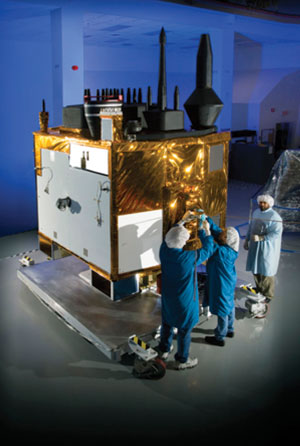
The antenna for the next-generation EMP sensor, BDV, is installed on a GPS satellite. (Copyright Boeing)
The group's newest instrument, built by Dors' team, is the space and atmospheric burst reporting system (SABRS), a highly modular package for detecting neutrons and gamma rays. It combines the 10 instruments on the DSP satellite into one compact package that is smaller, consumes less power, and weighs half as much as the old suite of instruments. Employing advanced on-board signal processing, SABRS autonomously evaluates a signal to determine what data must be sent to the ground for further processing. SABRS' compact design heightened the importance of understanding how the radiation sensors respond to and are affected by natural backgrounds. To test the new sensor technologies, the team developed SAVE, or the SABRS Validation Experiment. ("We like acronyms so much that we double up on them," notes Dors wryly.) SAVE was launched in November 2007 on the 23rd (and final) DSP satellite. These new instruments will help the satellite nuclear detonation detection program continue its monitoring mission. To the extent that monitoring inhibits treaty violations, that mission has been staggeringly successful—the last above-ground detonation occurred more than a quarter of a century ago. That's led some to question a program that essentially finds nothing—the so-called "silent sensor quandary." Mark Hodgson acknowledges the criticism but raises a counterpoint. "The probability of a nuclear explosion occurring is probably pretty low, but the consequences would be extremely high. We think the scales are tipped such that monitoring is worthy of continued support from the President. And the President always backs us up." —Jay Schecker |

Key words- nuclear detection, nuclear bomb, nuclear weapon, NUDET, neutron detector, gamma ray detector, EMP, electromagnetic pulse, x ray telescope, satellite, Vela, DSP, GPS, global monitoring, Limited Test Ban Treaty, Alexis, Forte, Cibola Flight Experiment, SABRE 
 Nuclear Detection 101
A nuclear explosion releases gamma rays, neutrons, x-rays, and radioactive debris and leads to the production of visible light and radio waves. One or more of these radiations can be seen by satellite-borne SNDD detectors thousands of kilometers above Earth.
For a detonation within 30 kilometers (km) of Earth's surface (bottom image), visible light is the primary detectable signal; the atmosphere prevents the gamma rays, neutrons, and debris from traveling into space. The gamma rays, however, collide with atmospheric atoms and dislodge electrons, which then emit radio waves when accelerated by the Earth's magnetic field. These large-amplitude, short-duration radio signals, known as nuclear electromagnetic pulses (EMPs), are also detected. For a detonation 30 to 100 kilometers above the Earth (middle), the atmosphere is thick enough to prevent particles from reaching space-based detectors. EMPs, although present, are not used in this altitude range for detection. Instead, visible light, x-rays, and gamma rays are the primary signals of interest. For a detonation above 100 kilometers (top), gamma rays, x-rays, neutrons, and other particles can be detected directly. 
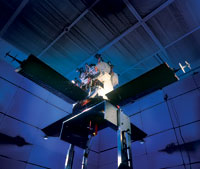
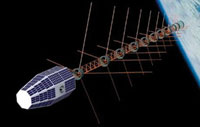
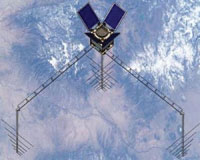
Validation Experiments
The instrumentation required for monitoring in the post–Cold War era was challenging to develop, so as soon as new technologies became available, they were incorporated into instruments. Los Alamos then had to validate these "higher risk" technologies for space use. To do so without impacting existing programs, the Laboratory built its own small satellites and had them launched into space with the prototype instruments on board. It was the ultimate "trial-by-fire." ALEXIS (Array of Low-Energy X-Ray Imaging Sensors, launched in 1993) was the first—a small satellite that tested sensors sensitive to the lower-energy x-rays that might come from a nuclear device. It was followed by FORTE (Fast On-orbit Recording of Transient Events, launched in 1997), often described as an antenna with a satellite attached. FORTE addressed how one might better detect an EMP but also had two Sandia-built optical packages for investigating terrestrial optical emissions. The Cibola Flight Experiment (CFE) was launched in 2007 to test several revolutionary concepts for space-borne computing. Cibola’s supercomputer was built from field-programmable gate arrays, chips that can be rewired at the touch of a software button. Errors induced in the non–radiation-tolerant chips by charged-particle bombardment could be corrected either in software or by rewiring the arrays. All of the validation experiments are dual purpose, with pure science goals co-mingled with mission-oriented ones. ALEXIS, for example, carried a broadband radio-frequency (RF) receiver—dubbed Blackbeard—that mapped the RF coming from Earth. (This background sets a lower detection limit for EMPs.) Scientists using Blackbeard discovered a class of cloud-to-cloud lightning discharges that emit light and very high frequency (VHF) radio waves. The discharges proved to be the most-powerful type of lightning in the VHF band. The mission response module is the latest validation experiment. Not a satellite, but a radio receiver, the module advances CFE technology and capability 100-fold in terms of processing speed. It will launch sometime in the future. Left to right: ALEXIS, FORTE, and Cibola satellites.
|